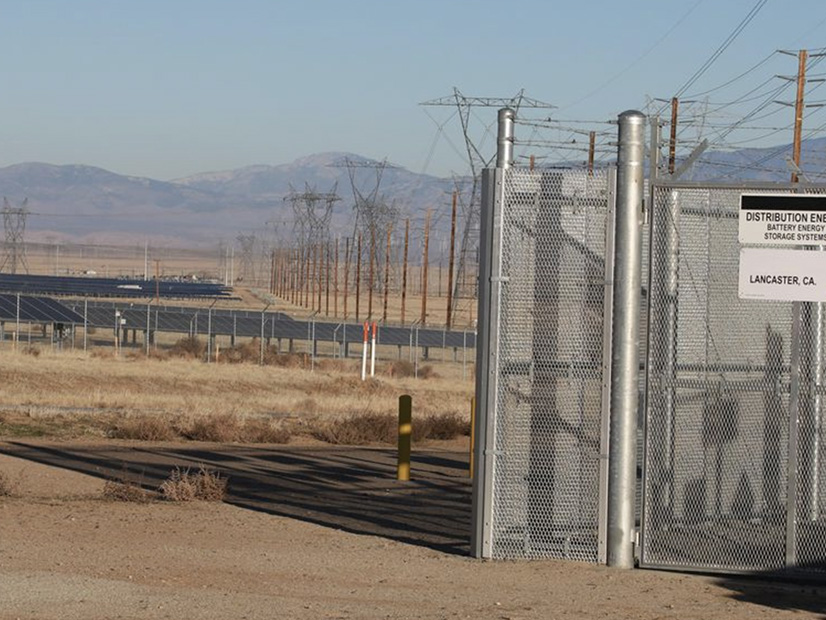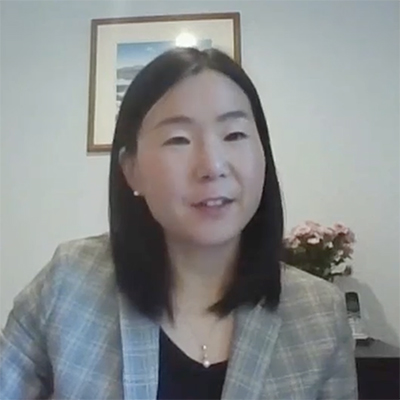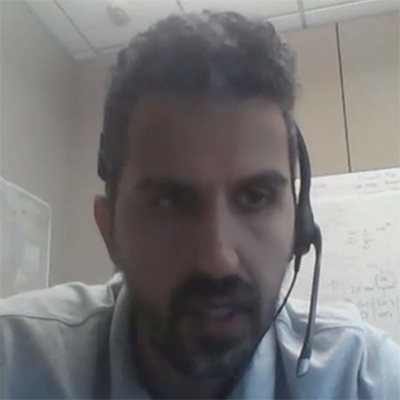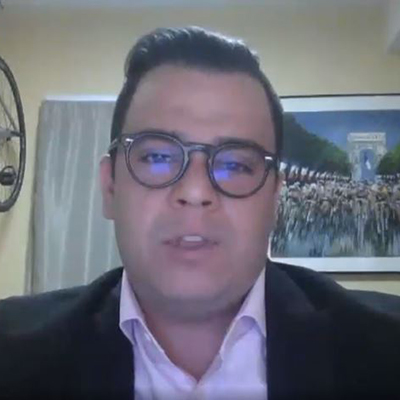
Participants at the final session of FERC’s technical conference on energy and ancillary services (E&AS) Tuesday agreed overall that market participation rules need to be revised to ease the entry of new and emerging resource types into the wholesale electricity markets (AD21-10).
“The panelists informed us of a lot about this incredibly complicated, challenging problem” of incenting new resources while maintaining grid reliability, concluded Emma Nicholson, an economist at FERC who helped moderate the day’s sessions. “We at staff are heartened by how many bright, smart people are analyzing this problem from different points of view so we can crowdsource some really good solutions here.”
The commission held the first session of the conference last month and now will likely issue a call for comments, she said. (See Flexible Ramping Grows as Ancillary Service.)
Revising RTO/ISO Market Models
Investors in new technologies such as storage resources, hybrid and co-located resources, aggregated distributed energy resources, and standalone variable energy resources want to be sure that the new assets will be able to offer their full operational capability in the market.
 Emma Nicholson, FERC | FERC
Emma Nicholson, FERC | FERCOn the other hand, RTOs and ISOs wrestle with the difficulty of adapting their market software and rules to accommodate such resources — an uncertainty factor — while fulfilling what many consider to be their primary responsibility of maintaining reliability.
There are two sides to the challenge of incorporating uncertainty into market software because providing electricity “is really preserving ramp capability from one interval to the next so that [it] can be available and deliverable in the next market run where uncertainty potentially materializes,” said George Angelidis, principal for power systems and market technology at CAISO.
The second aspect is coming up with a reasonable methodology for calculating the uncertainty requirement without tremendous effort because you have to do it constantly as the market runs to update the requirements, Angelidis said.
 George Angelidis, CAISO | FERC
George Angelidis, CAISO | FERCFor Jinye Zhao, principal analyst for advanced technology solutions at ISO-NE, the first question is how to reduce the magnitude of uncertainties; in other words, how to reduce the problem size.
“Given that there are always uncertainties in the system, what solution strategies can we use to manage uncertainties?” Zhao said.
Erik Ela, program manager for the Electric Power Research Institute, gave his perspective on ERCOT, which is not under FERC’s jurisdiction. Day-ahead forecasts for load, wind and solar used by the Texas grid operator are currently only used in the reliability unit commitment (RUC) process. This is run after the day-ahead market, with a primary focus of committing sufficient resources that require a day-ahead notification time while minimizing commitment costs, so resources committed in the day-ahead market are not de-committed, he said.
 Jinye Zhao, ISO-NE | FERC
Jinye Zhao, ISO-NE | FERC“If for example the renewable forecast is higher than the renewable bids, it is often the case that the incremental energy costs are ignored or largely discounted so that only the commitment costs are of concern,” Ela said.
The value of improved forecasts depends on both the amount of renewables and thermal units in the system, said Bethany Frew, senior engineer at the National Renewable Energy Laboratory.
“We’ve seen consistently across different studies almost a transition zone where as you start to increase the amount of renewables on your system, specifically variable renewable resources like wind and solar, and you start to reduce the amount of thermal units in the system, there’s this transition beyond which commitment-related impacts can be diminished,” Frew said.
 Erik Ela, EPRI | FERC
Erik Ela, EPRI | FERCSpecifically, start-up costs are one of the areas where NREL researchers see a lot of value in improved forecasts, but as thermal units are removed or they get retired in future scenarios, the value of those forecasts declines, she said.
“There’s really this interesting kind of interplay between what’s happening in the rest of the system and the forecast quality,” Frew said.
Arne Olson, senior partner at Energy and Environmental Economics, had multiple recommendations. First, market operators must develop scientific methods for determining the quantity of ancillary services needed based on continually changing grid conditions. The upward and downward reserve product should also be specified and procured separately. Wind and solar projects have asymmetric cost functions, which are only partly ameliorated when the services dispatch upward in real time, Olson said.
 Bethany Frew, NREL | FERC
Bethany Frew, NREL | FERC“Finally, and most ambitiously, we should look to market software to optimize the use of energy storage,” Olson said. “This is the most flexible resource available in the market, but its costs are entirely defined by market opportunities to buy low and sell high. As substantial quantities of storage are added, it will be increasingly important for market software to optimize its use.”
Ultimately, the ideal state at MISO would be to design and modify markets to remove barriers and create incentives for emergency-only resources such as load-modifying resources, said Laura Rauch, director of settlements for the RTO. “In particular, that long-lead emergency resources be committed and dispatched to market operations is a paradigm that enhances market efficiency for greater transparency.”
 Arne Olson, E3 | FERC
Arne Olson, E3 | FERCSPP deploys an uncertainty response team that talks on a daily basis and looks at the amount of uncertainty that the grid operator projects it will have to deal with, “and then the bulk responsibility of this team is to recommend some amount of capacity of generation that needs to be online,” said Yasser Bahbaz, manager of reliability coordination for the RTO. “And these are all recommendations that are made out-of-market because we don’t have a product that specifically deals with density and uncertainty.”
NYISO has been doing a good job for 20 years reducing out-of-market commitments, said Liam Baker, vice president of regulatory affairs for Eastern Generation. “Because of all the market power rules in New York City, I have to offer most of my products at cost or at zero. So as an investor … I want to see accurate price formation,” Baker said.
System Flexibility
One panel discussed whether energy and ancillary service market participation rules need to be changed to ensure that resources have incentives to offer operational flexibility to the RTO and ISO markets.
 Yasser Bahbaz, SPP | FERC
Yasser Bahbaz, SPP | FERCThe panelists stressed the importance of system flexibility in the markets.
Nicole Bouchez, principal economist in NYISO’s market design department, said New York is focused on the wholesale energy products that are needed for reliability “in the face of an evolving resource mix.” At the same time, Bouchez said, NYISO is also attempting to ensure the “broadest set of resources possible” can participate in the markets.
Bouchez said NYISO’s structure of market rules are designed to increase the financial returns for resources that perform flexibly and reliably in the real-time markets and reduce compensation for inflexible resources. Co-optimization in the energy and ancillary service markets and not in the day-ahead and real-time markets, Bouchez said, causes the prices to “reflect the cost of systems” that provide ancillary services and provide compensation when a unit “would otherwise be providing energy.”
“This opportunity to sell different products also has the potential to encourage resources to make investments or modify operating practices to participate in those markets,” Bouchez said. “These investments can, however, be costly, which is why the focus on reliability and the products needed to maintain reliability is so important.”
 Nicole Bouchez, NYISO | FERC
Nicole Bouchez, NYISO | FERCJoseph Daniel, manager of electricity markets and the climate and energy program for the Union of Concerned Scientists, stressed why he believes flexibility to be important. Daniel said flexibility boils down to “reliability and affordability” with a more flexible grid lowering costs for consumers and bringing reliability through new technologies.
Daniel said sometimes he finds it difficult to “disaggregate” some of the flexibility issues with what he calls “uneconomic behavior in the markets.” He said when he looks at the current rules governing the energy and ancillary services markets, he’s concluded that “most of today’s rules were written for yesterday’s resources” and all someone has to do to see the future is look at the generation queues of RTOs and ISOs to see the changing resource mix.
 Joseph Daniel, UCS | FERC
Joseph Daniel, UCS | FERCDaniel said he’s encouraged by FERC orders 841 and 2222 that demonstrate the commission is “working to find ways to accommodate that inevitable wave of lower cost, more flexible resources.” But he said rules governing the commitment and scheduling of resources “tend to bias towards inflexible, long lead-time resources” and work against newer, flexible technologies.
“FERC should pursue market fixes to promote competitive resources and to offer in the full range of possibility,” Daniel said. “As we make these steps towards creating market rules that will promote flexibility, we should recognize the limitations to that and try to find ways to make sure the market rules objectives actually achieve what we’re solving for.”
Michael McLaughlin, director of FERC’s Division of Economic and Technical Analysis, asked, “Do any existing RTO/ISO energy and ancillary service market rules, requirements or procedures actually encourage resources to offer into the market inflexibly, and if so, what changes should be made?”
 Catherine Tyler, Monitoring Analytics | FERC
Catherine Tyler, Monitoring Analytics | FERCCatherine Tyler, deputy market monitor for Monitoring Analytics, the Independent Market Monitor for PJM, said the way McLaughlin’s question was framed is “not quite the right” one. Tyler said stakeholders shouldn’t be worried whether resources offer flexibly but instead focus on the “need” for resources to perform flexibly.
Tyler said PJM rules require offering flexible parameters, including must-offer requirements in energy and reserve markets. She said there’s “plenty of flexibility on paper,” but there’s a “general lack of accountability” when it comes to performing flexibly in the markets. For example, there are no repercussions in the outage or uplift rules for failing to meet must-offer requirements. A potential solution would be penalties based on capacity market prices, which are paid for meeting certain performance standards.
“The market needs to account for the performance of the resources,” Tyler said. “Customers pay a premium for capacity that is meant to meet performance standards.”
Emerging Resources
Panelists discussed some of the issues keeping new technologies from entering and flourishing in markets.
 Jason Burwen, ESA | FERC
Jason Burwen, ESA | FERCJason Burwen, interim CEO of the Energy Storage Association, said one of the early lessons with the development of energy storage technology is that flexible storage is running into market processes that are not providing “commensurate operator control” and weren’t written with that technological capability in mind. It’s important for the commission to take a “wide view” on the paths forward on potential market rules to “continue to ensure policy keeps up with technology” and not allow technology limitations “constrain our future.”
“The grid of the future will need more flexible, fast-starting resources, and we need to make sure that we reflect the cost of a lack of performance meeting that,” Burwen said.
Aaron Siskind, an economist with FERC, asked whether existing RTO/ISO energy and ancillary services market rules, practices or procedures prevent or otherwise obstruct relatively new and emerging resource types, such as variable, hybrid and storage, from fully participating in RTO/ISO markets and offering the operational flexibility they are capable of providing from a technical standpoint.
 Walter Graf, PJM | FERC
Walter Graf, PJM | FERCMichael DeSocio, director of market design for NYISO, said the current market structure is “built to reward those that can move quickly, follow dispatch instructions closely and be responsive to emerging grid needs.” To be prepared for the continuing energy transition and the grid of the future, stakeholders need to “think more broadly” on solutions for market structures to ensure resources continue to respond to grid needs and operator instructions. He said there is also “a need to provide additional information more frequently” by resources submitting more data to the RTOs and ISOs for more efficient operations.
“This promotes improved efficiency and better price formation,” DeSocio said. “All of these pieces and parts are important.”
Walter Graf, senior director of economics for PJM, said the objective should not be to maximize operational flexibility but to “incentivize the efficient level of operational flexibility across all resources.” PJM is behind other areas in the country in respect to the penetration of emerging and intermittent technologies, giving it the “benefit” of having more time to address market design deficiencies “before they become problems.”
Graf said PJM “continues to believe in the ability of the competitive market to signal value through prices” and the ability of market participants to best make decisions. Graf said incentivizing flexibility and ensuring that sufficient flexibility is available when needed is the role of the energy and ancillary service markets.
“PJM believes that operational needs should guide the design of needed services and should not be compromised to accommodate resources that are unable to comply,” Graf said. “That said, there are cases where value can be unlocked or enabled without compromising operational requirements.”

